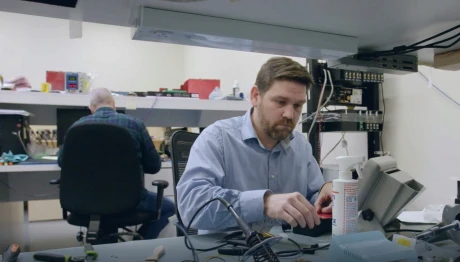Case study

For over 20 years, InterTalk Critical Information Systems has been supporting daily operations in public safety, transportation, government and utilities sectors. With its complete suite of IP-based radio and telephony communication products, InterTalk delivers critical information at the right time, in the right format. The company is based in Nova Scotia, Canada.
Accurate and consistent time tracking for R&D tax incentive program
InterTalk used to rely on traditional timeshee each employee had to fill out on a weekly basis. “It was very difficult and laborious, and not rigidly enforced by management,” Matthew MacDonald, Chief Engineer at InterTalk, recalls. As any manual timekeeping method, traditional timesheets were cumbersome and unreliable.
The opportunity to apply for the R&D tax incentive program provided by the Canadian government became a turning point for InterTalk. To be eligible for the program and claim its benefits, the company had to regularly submit proper documentation, including individual working time records, team payroll expenses, a list of performed activities and time spent on them. More than that, they were required to differentiate between eligible and non-eligible work, which was impossible with the existing paper timesheets.
InterTalk made a decision to introduce online timesheet software. The company vetted a number of options and chose to go with actiTIME as the best fit in terms of cost and value.
The main driver to implement actiTIME was the SR&ED tax-incentive program. It has since grown to include other uses within the company with regard to financial projections.



Importance of time tracking for R&D tax incentive program
“One of the challenges we face as a technology company is that you’re never done. In order to survive, you have to keep building new things. We have several large development and innovation teams, and they do a lot of software and hardware development and technology research,” Matthew shares.
Companies in Canada that invest in R&D activities can take part in a tax incentive program Scientific Research & Experimental Development (SR&ED). This program incentivizes companies to push the boundaries of technology. The company size or industry doesn’t matter - it’s only the activities that count.
“Anything involving researching new technologies, doing experiments, building proof of concept models or prototypes, doing any field beta testing – anything that involves experimental design or development of a new technology can essentially count as part of this incentive program. Once the technology goes live in a commercial environment, it’s no longer considered experimental,” Matthew explains.
In order to apply for the program and claim the R&D tax credit, InterTalk was required to provide detailed reports of time spent on R&D activities, notes and summaries describing the progress of tax-eligible work.
All this goes straight into our tax form. We have summaries that we have to write, we have to provide the developers’ notes if asked for, we have to provide resumes and biographies – there’s quite a lot of information you provide for it.
R&D teams at InterTalk document their work progress in JIRA and record working time across clients, projects and tasks in actiTIME. Not to miss tax-eligible time and work details, engineers use task comments in actiTIME to add links to the respective JIRA tickets describing activity details. “That is one of the main uses of time tracking at InterTalk,” Matthew sums up.
Favorite actiTIME Features



Agile project management with actiTIME
Engineering and development teams at InterTalk work in the Agile environment and rely on continuous improvement to deliver quality solutions.To fit time and cost budgets, Agile projects require activity estimation and proper project planning and this is where actiTIME comes in handy.
“One of the biggest challenges with any software company is understanding how long something’s going to take and how that fits up with project budgeting, timelines or costs. When we’re trying to budget our new project, we can go back to actiTIME and look at historical data - how much time we spent on design, development, quality assurance or project management in some of our previous projects. Then we try to predict how much time we need to budget for the project in the future. actiTIME has been really useful for us in that,” says Matthew.
Jennifer says actiTIME makes project estimates more accurate: “Time estimates allow us to identify productivity patterns in different departments, and makes it much more reliable to say that one team is going to need 1500 hours and another team might need 400 hours for their job. Now we are able to see those patterns and apply that to our fees going out the door.”
Historical data also helps InterTalk manage resources: “actiTIME usually has been helpful in that because we’re able to look at the time we spent on past projects and use that to predict how much time we’ll need for future projects and whether we’re going to need extra help down the road or extra staffing,” Matthew says.
General impression of actiTIME
InterTalk implemented actiTIME as timesheet software to track time for the R&D tax incentive program but it gradually became an essential tool for project planning and workload management.
“It's online and easy to use, making it more difficult not to use, leading to consistent, detailed results,” says Matthew.
More Stories
your business to the next level?
Let us save your time with a 15-minute product tour.













































